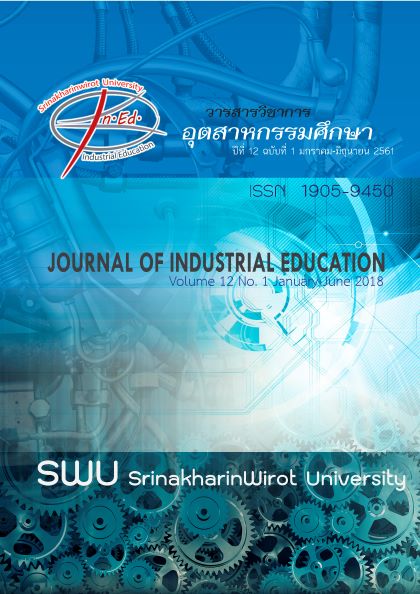การพัฒนาบทเรียนอีเลิร์นนิ่งตามสภาพแวดล้อมทางการเรียนส่วนบุคคลบนเครือข่ายสังคมออนไลน์ เรื่อง ระบบเครือข่ายคอมพิวเตอร์และการสื่อสารข้อมูลพื้นฐาน
Abstract
การพัฒนาบทเรียนอีเลิร์นนิ่งตามสภาพแวดล้อมทางการเรียนส่วนบุคคลบนเครือข่ายสังคมออนไลน์ เรื่อง ระบบเครือข่ายคอมพิวเตอร์และการสื่อสารข้อมูลพื้นฐาน พุทธมนต์ อัจฉริยนนท์, ไพโรจน์ เบาใจ, พูลศรี เวศย์อุฬาร สาขาวิชาเทคโนโลยีการศึกษาและการสื่อสาร มหาวิทยาลัยราชภัฏจันทรเกษม บทคัดย่อ การวิจัยครั้งนี้มีวัตถุประสงค์เพื่อ (1) พัฒนาบทเรียนอีเลิร์นนิงตามสภาพแวดล้อมทางการเรียนส่วนบุคคลบนเครือข่ายสังคมออนไลน์ เรื่อง ระบบเครือข่ายคอมพิวเตอร์และการสื่อสารข้อมูลพื้นฐาน ให้ได้ไม่ต่ำกว่าเกณฑ์ 80/80 (2) หาค่าดัชนีประสิทธิผลจากการเรียนด้วยบทเรียนอีเลิร์นนิงที่พัฒนาขึ้นให้มีค่าไม่ต่ำกว่า 0.70 (3) ศึกษาเปรียบเทียบผลสัมฤทธิ์ทางการเรียนระหว่างกลุ่มควบคุมที่เรียนจากการสอนแบบปรกติกับกลุ่มทดลองที่เรียนจากบทเรียนอีเลิร์นนิง (4) ศึกษาความคงทนในการเรียนรู้หลังจากเรียนด้วยบทเรียน อีเลิร์นนิงเมื่อเรียนผ่านมาแล้ว 2 สัปดาห์ และ 4 สัปดาห์ และ (5) ศึกษาความพึงพอใจของนักศึกษาที่มีต่อการเรียนแบบอีเลิร์นนิง ประชากรที่ใช้ในการศึกษา ได้แก่ นักศึกษาระดับปริญญาตรี มหาวิทยาลัยราชภัฏจันทรเกษม จำนวน 150 คน สุ่มเลือกกลุ่มตัวอย่างด้วยการสุ่มแบบง่าย จำนวน 60 คน ซึ่งกำลังศึกษาในภาคเรียนที่ 1 ปีการศึกษา 2559 แบ่งเป็นกลุ่มทดลองและกลุ่มควบคุม กลุ่มละ 30 คน เครื่องมือที่ใช้ในการวิจัย ประกอบด้วย (1) บทเรียนอีเลิร์นนิงตามสภาพแวดล้อมทางการเรียนส่วนบุคคลบนเครือข่ายสังคมออนไลน์ เรื่อง ระบบเครือข่ายคอมพิวเตอร์และการสื่อสารข้อมูลพื้นฐาน (2) แบบทดสอบวัดผลสัมฤทธิ์ทางการเรียนและความคงทนในการเรียนรู้ (3) แบบวัดความพึงพอใจของนักศึกษาต่อการเรียนแบบอีเลิร์นนิง (4) แบบประเมินคุณภาพสำหรับผู้เชี่ยวชาญด้านเนื้อหาและอีเลิร์นนิง สถิติที่ใช้ในการวิจัย ได้แก่ ค่าร้อยละค่าเฉลี่ย ค่าเบี่ยงเบนมาตรฐาน และทดสอบสมมติฐานโดยใช้ t-test แบบ Independent Sample และ Dependent Sample ผลการวิจัย พบว่า (1) บทเรียนอีเลิร์นนิงตามสภาพแวดล้อมทางการเรียนส่วนบุคคลบนเครือข่ายสังคมออนไลน์ เรื่อง ระบบเครือข่ายคอมพิวเตอร์และการสื่อสารข้อมูลพื้นฐาน มีประสิทธิภาพเท่ากับ 82.17/86.89 ซึ่งเป็นไปตามเกณฑ์ที่กำหนดไว้ (2) มีค่าดัชนีประสิทธิผลเท่ากับ .7796 ทำให้นักศึกษาเกิดการเรียนรู้คิดเป็นร้อยละ 77.96 (3) เมื่อเปรียบเทียบผลสัมฤทธิ์ทางการเรียน พบว่า กลุ่มทดลองมีผลสัมฤทธิ์ทางการเรียนสูงกว่ากลุ่มควบคุมอย่างมีนัยสำคัญทางสถิติที่ระดับ .05 (4) ความคงทนในการเรียนรู้หลังจากเรียนด้วยบทเรียนอีเลิร์นนิง เมื่อเรียนผ่านไปแล้ว 2 สัปดาห์ และ 4 สัปดาห์กับการทดสอบหลังเรียนทันทีมีผลการเรียนรู้ไม่แตกต่างกันอย่ามีนัยสำคัญทางสถิติ แสดงว่าบทเรียนที่พัฒนาขึ้นส่งผลต่อความคงทนในการเรียนรู้ และ (5) นักศึกษามีความพึงพอใจต่อการเรียนแบบอีเลิร์นนิงอยู่ในระดับมากเพราะคุณค่าที่ได้จากประสบการณ์เรียนแบบอีเลิร์นนิง ดังนั้น บทเรียนอีเลิร์นนิงที่พัฒนาขึ้นสามารถนำไปใช้เพื่อการเรียนการสอนต่อไปในอนาคตได้ คำสำคัญ: อีเลิร์นนิง, การจัดสภาพแวดล้อมทางการเรียนส่วนบุคคล, เครือข่ายสังคมออนไลน์ Development of e-Learning based upon Online Personal Learning Environment through Social Network on Computer Networking and Data Communication Infrastructure. Puttamon Achariyanont , Pairoj Bowjai, Poonsri Vate-U-Lan Department of Education Technology and Communications Chandrakasem Rajabhat University Abstract: The objectives of this research were (1) to develop an e-Learning base upon online personal learning environment through social networks on computer networking and data communications infrastructure to not less than the 80/80 (E1/E2) efficiency criteria (2) to study an effectiveness index of the developed e-Learning to not less than 0.70 (3) to compare learning achievement between a control group in traditional instruction and an experimental group in e-Learning courseware (4) to examine students’ retention after completing the course for 2 and 4 weeks and (5) to investigate students’ satisfaction towards the developed e-Learning courseware. The population was 150 undergraduate students at Chandrakasem Rajabhat University. 60 students were selected by a simple random sampling technique; they were divided into 2 groups: an experimental group and a control group, each group consisting of 30 students. The research instruments were (1) the e-Learning base upon online personal learning environment through social networks on computer networking and data communications infrastructure (2) an achievement test (3) a student’s satisfaction appraisal towards the e-Learning which included 20 items of 5-points rating scale and (4) a quality appraisal for content experts and e-Learning experts. The statistics used in this current research were mean, percentages, independent samples and dependent samples t-test. The research findings were: (1) the e-Learning courseware achieved the efficiency at 82.17/86.89 which met a predetermined criterion, (2) an effectiveness index was .7796 which gained 77.96 percent of students’ knowledge increased accordingly, (3) a comparison of students’ achievement found that the experimental group earned higher achievement rather than the control group, statistically significant at the .05 level, (4) the learning retention of experiment group students after completing the course and after 2 and 4 weeks later were not statistically significant different which could be implied that the developed e-Learning culminated in the learning retention and (5) the students were positively satisfied at above average level because of valued experience from the experiment. Therefore, the developed e-Learning can be implemented for future instruction. Keyword: e-Learning, online personal learning environment, social networksDownloads
Download data is not yet available.
Downloads
Issue
Section
บทความวิจัย







